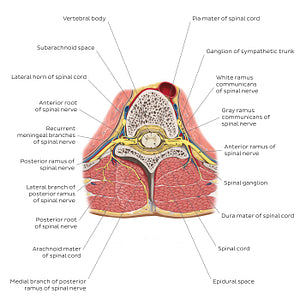Paul Kim
Spinal cord in situ (English)
Spinal cord in situ (English)
On exiting the intervertebral foramen, each spinal nerve divides into anterior and posterior rami. The posterior ramus extends in a posterior direction and further divides into medial and lateral branches, which provide innervation to the deep back muscles (epaxial muscles) as well as an associated narrow strip of overlying skin. The anterior ramus provides motor innervation (somatic or visceral) to the rest of the body related to that segmental level, often intermingling with other spinal nerves leading to the formation of the major somatic plexuses (cervical, brachial, lumbar and sacral). Just before the bifurcation into anterior and posterior rami, the spinal nerve also gives rise to one or more recurrent /meningeal branches which re-enter the intervertebral foramen to supply the meninges and other structures of the vertebral canal. Communicating with the anterior ramus of the spinal nerves are the white and gray rami communicantes which convey sympathetic nerve fibers. The anterior rami of spinal nerves T1-L2 give off the white ramus communicans which carries preganglionic sympathetic fibers from the lateral horn of the spinal cord to an adjacent sympathetic ganglion. Here they can either synapse with a postganglionic sympathetic neuron at the same or a superior/inferior level via the sympathetic trunk, or pass through the sympathetic ganglion (without synapsing) continuing as a preganglionic nerve fiber; in all cases nerve fibers of the sympathetic trunk reenter the spinal nerves via a gray ramus communicans.
Precio habitual
$7.56 USD
Precio habitual
Precio de oferta
$7.56 USD
Precio unitario
por
No se pudo cargar la disponibilidad de retiro


#BC363E
#5A8DA1
#A0202B
#5F4B38
#FDEC75 y #CBB5AE

